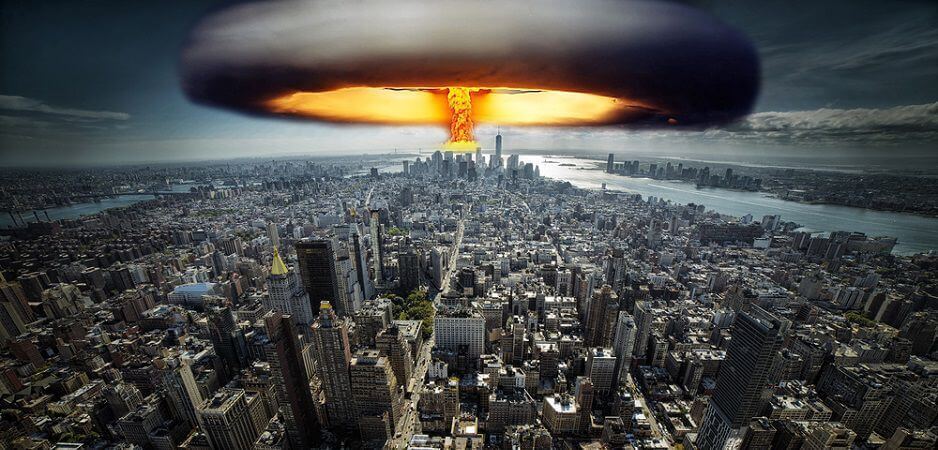Today’s real and present nuclear danger seems so much more immediate because Trump has his unstable hand on the nuclear button.
The United States of America is the only nation on earth that has ever purposely used nuclear weapons to kill human beings — approximately 66,000 dead in Hiroshima and another 39,000 dead in Nagasaki. Despite this uncomfortable fact, America has shamefully developed even more and deadlier nuclear weapons while, with a straight face, its leaders perpetually claim that the nation needs to do so in order to prevent others from doing what America has already done.
So while America clearly stands at the top of the nuclear food chain, other nations have stepped up to join us in an insane game of nuclear chicken. The latest player is North Korea, but it is hardly the most threatening. When America alone had a nuclear weapon, using one or two seemed like a good idea to some. Now that other countries have a few at the ready, it shouldn’t ever seem like a good idea to anyone.
WHO HAS WHAT?
So let’s review the state of play. Nine nations are known to have nuclear weapons: the United States (6,800 warheads), Russia (7,000), the United Kingdom (215), France (300), China (270), India (110-120), Pakistan (120-130), Israel (80) and North Korea (under 10). In this context, it is perhaps worth noting that the US is believed to spend more on its nuclear arsenal than all other nations combined.
Only one nation, South Africa, actually developed nuclear weapons and then later dismantled its nuclear weapons and terminated its nuclear weapons program. Other nations, most notably Iran and Libya, have begun development of nuclear weapons and, for one reason or another, have decided to forego completing the process.
This brings us to the Nuclear Non-Proliferation Treaty (NPT). This international treaty is designed to limit the spread of nuclear weapons and nuclear weapons technology, while providing a framework for continued access to nuclear technology for peaceful purposes.
Since the NPT’s entry into force in 1970, when there were five treaty-identified nuclear weapon states (the US, Russia, France, the UK and China), 190 states have joined and agreed to abide by its terms and conditions. Very significantly, of the nine states that currently have nuclear weapons, only the original five have signed on to the treaty (North Korea originally acceded to the NPT, but withdrew in 2003).
This leaves an obvious hole through which nuclear weapons technology can and has been disseminated by nations with the technology that are unrestrained by NPT obligations. This situation is unlikely to change without a significant change to the treaty that would allow for an updated list of nuclear weapon states and a prospective non-proliferation commitment from those states.
THE NUCLEAR REALITY TODAY
Now we can fast forward to 2017 and a world made much more dangerous by the actual proliferation of nuclear weapons and the presence on the world stage of a couple of narcissistic morons pointing them at each other. With India and Pakistan both locked and loaded, the notion that two nuclear weapon states could face off at any time has been a real and present danger for quite some time. And never far from view is the possibility of nuclear confrontation in the Middle East, where the nuclear capable Iran and the unaccountable nuclear weapon state of Israel continue their open hostility.
Yet even with these longstanding potential crises and other past crises in mind, today’s real and present nuclear danger seems so much more immediate in the American context (not to mention what the South Koreans must be thinking). Perhaps this is because it is our danger. More likely, it is because Trump has his unstable hand on the nuclear button. For many in the international community, it is surely the latter.
In response, some concrete and objective steps could be taken by all those who actually understand today’s nuclear peril. First, accept the fact that North Korea has nuclear weapons and shows no more inclination to give them up than America does to give up its nuclear arsenal.
As we have seen with India and Pakistan for the last 20 years, two countries with deep-seated enmity that share huge borders and have significant nuclear arsenals can somehow accept those realities, while each nation works hard to confront the nuclear insanity within. North Korea and the US share no borders, and the US has a vastly superior nuclear arsenal. Until Trump came along, that seemed enough to permit a slow progression to a nuclear weapons capability in North Korea without anyone shouting about impending nuclear war.
To fully appreciate the present threat, it is important to note that nuclear weapons don’t normally detonate without human assistance and that all nuclear weapons states have important safeguards in place to protect against mistaken deployment. That having been said, it is way beyond time to give Trump a tranquilizer while American and North Korean experts define the terms of an agreement in which each recognizes the other’s weaponry and each pledges never to use it in anger.
While working hard to step North Korea and the US away from some nuclear brink, the second critical element in reducing the immediate nuclear peril is to do everything that can be done to support the Iran nuclear deal. This deal is a critical model for international efforts to reduce the further proliferation of nuclear weapons.
As with the Korean situation, fully supporting the Iran nuclear deal will require confronting significant truths. The first is that Iran has the technical capability to develop and produce nuclear weapons and has unilaterally put that capability on hold. Second, Israel has nuclear weapons already, is unwilling to give them up, and remains completely unwilling to participate in the types of international treaty obligations that might reduce their regional threat. By encouraging Iran’s commitments and outing Israel in an effort to reduce nuclear tensions, America and some of Israel’s staunchest allies might even be able to move the nuclear discussion to a more comprehensive agenda based on a more balanced view of peace in the Middle East.
 Along with providing some nuclear basics, I seek to encourage an environment in which the international community demonstrates a capacity to make the world a safer place by successfully confronting and resolving the difficult issues associated with the proliferation of nuclear weapons. Success on this front would make me, and I imagine many others, feel more inclined to believe that there can be constructive measures taken to confront climate change, grinding poverty, terrorism, international public health crises and other seemingly intractable threats to human life.
Along with providing some nuclear basics, I seek to encourage an environment in which the international community demonstrates a capacity to make the world a safer place by successfully confronting and resolving the difficult issues associated with the proliferation of nuclear weapons. Success on this front would make me, and I imagine many others, feel more inclined to believe that there can be constructive measures taken to confront climate change, grinding poverty, terrorism, international public health crises and other seemingly intractable threats to human life.
Today, the world seems to be evolving rapidly from a world somewhat under control to something far worse — a world in which the increased potential for nuclear destruction is but one of many factors creating a sense that we are living in perilous times with many more critical problems than solutions. Maybe that evolution can be slowed or reversed by starting somewhere and succeeding. At the least, genuinely reducing today’s threat of nuclear war would be a good place to start.
*[A version of this article was also featured on Larry Beck’s blog, Hard Left Turn.]
The views expressed in this article are the author’s own and do not necessarily reflect Fair Observer’s editorial policy.
Photo Credit: Nicola Bertolini / Shutterstock.com
Support Fair Observer
We rely on your support for our independence, diversity and quality.
For more than 10 years, Fair Observer has been free, fair and independent. No billionaire owns us, no advertisers control us. We are a reader-supported nonprofit. Unlike many other publications, we keep our content free for readers regardless of where they live or whether they can afford to pay. We have no paywalls and no ads.
In the post-truth era of fake news, echo chambers and filter bubbles, we publish a plurality of perspectives from around the world. Anyone can publish with us, but everyone goes through a rigorous editorial process. So, you get fact-checked, well-reasoned content instead of noise.
We publish 2,500+ voices from 90+ countries. We also conduct education and training programs
on subjects ranging from digital media and journalism to writing and critical thinking. This
doesn’t come cheap. Servers, editors, trainers and web developers cost
money.
Please consider supporting us on a regular basis as a recurring donor or a
sustaining member.
Will you support FO’s journalism?
We rely on your support for our independence, diversity and quality.






